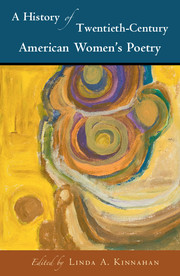Book contents
- Frontmatter
- Contents
- List of figures
- List of contributors
- Preface
- Acknowledgments
- PART I MAPPINGS AND CHRONOLOGIES
- 1 Critical Mapping I: The Category of the “Woman Poet” – An Introduction, by Way of Mapping
- 2 Critical Mapping II: Reading American Poetry by Women
- 3 Chronology I: American Women Poets, 1900–1950
- 4 Chronology II: American Women Poets, 1950–2000
- PART II ETHNICITY, RACE, AND IDENTITY
- PART III MATERIAL FORMATIONS
- PART IV LINEAGES, TIES, AND CONNECTIONS
- PART V FORM, LANGUAGE, AND TEXT
- PART VI CODA
- Bibliography
- Index
2 - Critical Mapping II: Reading American Poetry by Women
from PART I - MAPPINGS AND CHRONOLOGIES
Published online by Cambridge University Press: 05 June 2016
- Frontmatter
- Contents
- List of figures
- List of contributors
- Preface
- Acknowledgments
- PART I MAPPINGS AND CHRONOLOGIES
- 1 Critical Mapping I: The Category of the “Woman Poet” – An Introduction, by Way of Mapping
- 2 Critical Mapping II: Reading American Poetry by Women
- 3 Chronology I: American Women Poets, 1900–1950
- 4 Chronology II: American Women Poets, 1950–2000
- PART II ETHNICITY, RACE, AND IDENTITY
- PART III MATERIAL FORMATIONS
- PART IV LINEAGES, TIES, AND CONNECTIONS
- PART V FORM, LANGUAGE, AND TEXT
- PART VI CODA
- Bibliography
- Index
Summary
Feminist critique has altered – or at least challenged – many things: laws and policy, cultural products, fields of study, subjectivities, ethics, historical knowledge, what is looked for and what is seen. Feminist critique offers analytic anatomies of and passionate resistance to customs and assumptions concerning gender, including those enshrined in literature. Such critique intervened in the interpretation of poetry, constructing a reading category, poetry by women, and integrating social and aesthetic analyses of works and careers. Existing practices of poetry have offered various traditional positions for female figures; among these are idealized beauty and goodness, powerful muse behaviors to inspire others, spirits of nature and bounty, and passive droopiness, even unto poetic death. This array creates particular problems for actual women in literary production (the writing of work) and in reception (the reading of work). Like all women, women poets have had a historically shifting relationship to cultural institutions – to their professions in terms of publication, distribution, and evaluation, to reward systems and authority – access, that is, to meaningful memory of their achievements, both for themselves and on the behalf of culture at large. No matter the social gains for women over time, women as writers – often quite against their wills, hopes, and goals – have a differential relationship to culture, a relationship that can be startlingly divergent from men's.
Where women and other minoritized writers are concerned, many assumptions about their work – viewed as inadequate, lacking, immature, unnecessary, imitative, hesitant, without authority, devoid of cultural or literary capital, or conversely too brassy, outspoken, unsubtle, emotional – make their structural relation to such literary traditions discussable as a separate critical category. Such differentials make them prime candidates for the “feminism of reception” – a rectification strategy for reading that gives an empathetic hearing to the disparaged or semi-lost, while alert for the norms and ideologies constructing historical gender – and their literary manifestations.
The reception category “poetry by women” offers a cultural context for reading this work and reclaiming its vitality with nuanced studies of poets (individually or in groups) who were once present, productive, palpable, and yet forgotten, or undercut by sexism or by themselves; or active and then erased; or thought of as exceptionalist tokens, representative of no necessary cultural meanings.
- Type
- Chapter
- Information
- A History of Twentieth-Century American Women's Poetry , pp. 26 - 40Publisher: Cambridge University PressPrint publication year: 2016

